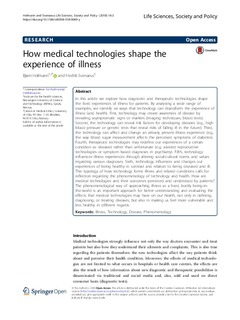| dc.contributor.author | Hofmann, Bjørn | |
| dc.contributor.author | Svenaeus, Fredrik | |
| dc.date.accessioned | 2019-04-09T07:09:04Z | |
| dc.date.available | 2019-04-09T07:09:04Z | |
| dc.date.created | 2018-06-18T14:38:34Z | |
| dc.date.issued | 2018 | |
| dc.identifier.citation | Life Sciences, Society and Policy. 2018, 14 (3), . | nb_NO |
| dc.identifier.issn | 2195-7819 | |
| dc.identifier.uri | http://hdl.handle.net/11250/2593783 | |
| dc.description.abstract | In this article we explore how diagnostic and therapeutic technologies shape the lived experiences of illness for patients. By analysing a wide range of examples, we identify six ways that technology can (trans)form the experience of illness (and health). First, technology may create awareness of disease by revealing asymptomatic signs or markers (imaging techniques, blood tests). Second, the technology can reveal risk factors for developing diseases (e.g., high blood pressure or genetic tests that reveal risks of falling ill in the future). Third, the technology can affect and change an already present illness experience (e.g., the way blood sugar measurement affects the perceived symptoms of diabetes). Fourth, therapeutic technologies may redefine our experiences of a certain condition as diseased rather than unfortunate (e.g. assisted reproductive technologies or symptom based diagnoses in psychiatry). Fifth, technology influences illness experiences through altering social-cultural norms and values regarding various diagnoses. Sixth, technology influences and changes our experiences of being healthy in contrast and relation to being diseased and ill. This typology of how technology forms illness and related conditions calls for reflection regarding the phenomenology of technology and health. How are medical technologies and their outcomes perceived and understood by patients? The phenomenological way of approaching illness as a lived, bodily being-in-the-world is an important approach for better understanding and evaluating the effects that medical technologies may have on our health, not only in defining, diagnosing, or treating diseases, but also in making us feel more vulnerable and less healthy in different regards. | nb_NO |
| dc.language.iso | eng | nb_NO |
| dc.publisher | BioMed Central | nb_NO |
| dc.rights | Navngivelse 4.0 Internasjonal | * |
| dc.rights.uri | http://creativecommons.org/licenses/by/4.0/deed.no | * |
| dc.title | How medical technologies shape the experience of illness | nb_NO |
| dc.type | Journal article | nb_NO |
| dc.type | Peer reviewed | nb_NO |
| dc.description.version | publishedVersion | nb_NO |
| dc.source.pagenumber | 11 | nb_NO |
| dc.source.volume | 14 | nb_NO |
| dc.source.journal | Life Sciences, Society and Policy | nb_NO |
| dc.source.issue | 3 | nb_NO |
| dc.identifier.doi | 10.1186/s40504-018-0069-y | |
| dc.identifier.cristin | 1591972 | |
| dc.description.localcode | © The Author(s). 2018. Open Access | nb_NO |
| cristin.unitcode | 194,65,70,0 | |
| cristin.unitname | Institutt for helsevitenskap Gjøvik | |
| cristin.ispublished | true | |
| cristin.fulltext | original | |
| cristin.qualitycode | 1 | |

